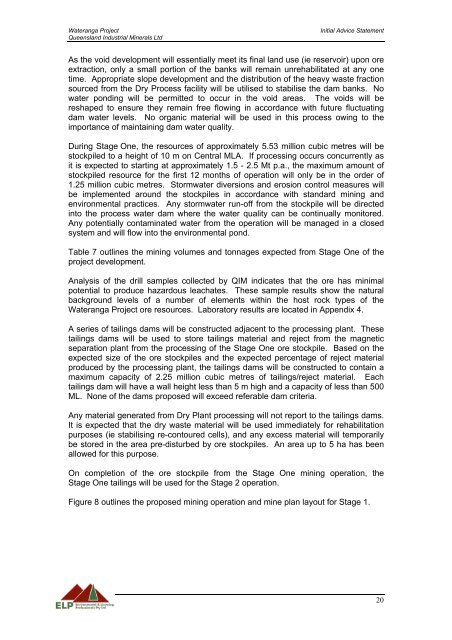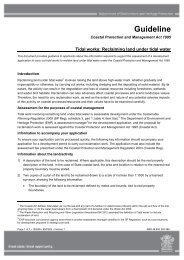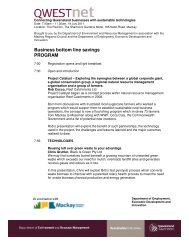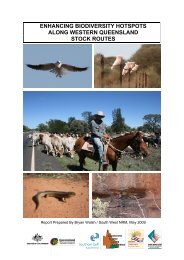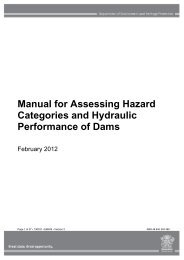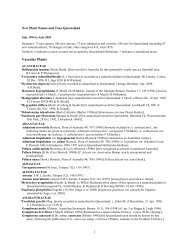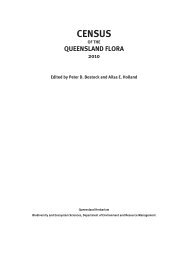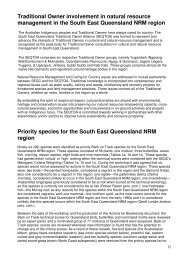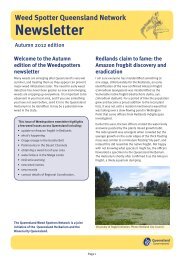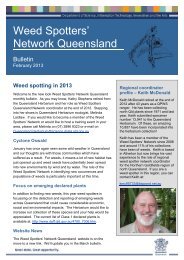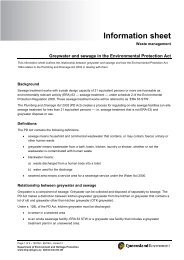WATERANGA PROJECT - Department of Environment and Heritage ...
WATERANGA PROJECT - Department of Environment and Heritage ...
WATERANGA PROJECT - Department of Environment and Heritage ...
Create successful ePaper yourself
Turn your PDF publications into a flip-book with our unique Google optimized e-Paper software.
Wateranga Project Initial Advice Statement<br />
Queensl<strong>and</strong> Industrial Minerals Ltd<br />
As the void development will essentially meet its final l<strong>and</strong> use (ie reservoir) upon ore<br />
extraction, only a small portion <strong>of</strong> the banks will remain unrehabilitated at any one<br />
time. Appropriate slope development <strong>and</strong> the distribution <strong>of</strong> the heavy waste fraction<br />
sourced from the Dry Process facility will be utilised to stabilise the dam banks. No<br />
water ponding will be permitted to occur in the void areas. The voids will be<br />
reshaped to ensure they remain free flowing in accordance with future fluctuating<br />
dam water levels. No organic material will be used in this process owing to the<br />
importance <strong>of</strong> maintaining dam water quality.<br />
During Stage One, the resources <strong>of</strong> approximately 5.53 million cubic metres will be<br />
stockpiled to a height <strong>of</strong> 10 m on Central MLA. If processing occurs concurrently as<br />
it is expected to starting at approximately 1.5 - 2.5 Mt p.a., the maximum amount <strong>of</strong><br />
stockpiled resource for the first 12 months <strong>of</strong> operation will only be in the order <strong>of</strong><br />
1.25 million cubic metres. Stormwater diversions <strong>and</strong> erosion control measures will<br />
be implemented around the stockpiles in accordance with st<strong>and</strong>ard mining <strong>and</strong><br />
environmental practices. Any stormwater run-<strong>of</strong>f from the stockpile will be directed<br />
into the process water dam where the water quality can be continually monitored.<br />
Any potentially contaminated water from the operation will be managed in a closed<br />
system <strong>and</strong> will flow into the environmental pond.<br />
Table 7 outlines the mining volumes <strong>and</strong> tonnages expected from Stage One <strong>of</strong> the<br />
project development.<br />
Analysis <strong>of</strong> the drill samples collected by QIM indicates that the ore has minimal<br />
potential to produce hazardous leachates. These sample results show the natural<br />
background levels <strong>of</strong> a number <strong>of</strong> elements within the host rock types <strong>of</strong> the<br />
Wateranga Project ore resources. Laboratory results are located in Appendix 4.<br />
A series <strong>of</strong> tailings dams will be constructed adjacent to the processing plant. These<br />
tailings dams will be used to store tailings material <strong>and</strong> reject from the magnetic<br />
separation plant from the processing <strong>of</strong> the Stage One ore stockpile. Based on the<br />
expected size <strong>of</strong> the ore stockpiles <strong>and</strong> the expected percentage <strong>of</strong> reject material<br />
produced by the processing plant, the tailings dams will be constructed to contain a<br />
maximum capacity <strong>of</strong> 2.25 million cubic metres <strong>of</strong> tailings/reject material. Each<br />
tailings dam will have a wall height less than 5 m high <strong>and</strong> a capacity <strong>of</strong> less than 500<br />
ML. None <strong>of</strong> the dams proposed will exceed referable dam criteria.<br />
Any material generated from Dry Plant processing will not report to the tailings dams.<br />
It is expected that the dry waste material will be used immediately for rehabilitation<br />
purposes (ie stabilising re-contoured cells), <strong>and</strong> any excess material will temporarily<br />
be stored in the area pre-disturbed by ore stockpiles. An area up to 5 ha has been<br />
allowed for this purpose.<br />
On completion <strong>of</strong> the ore stockpile from the Stage One mining operation, the<br />
Stage One tailings will be used for the Stage 2 operation.<br />
Figure 8 outlines the proposed mining operation <strong>and</strong> mine plan layout for Stage 1.<br />
20


